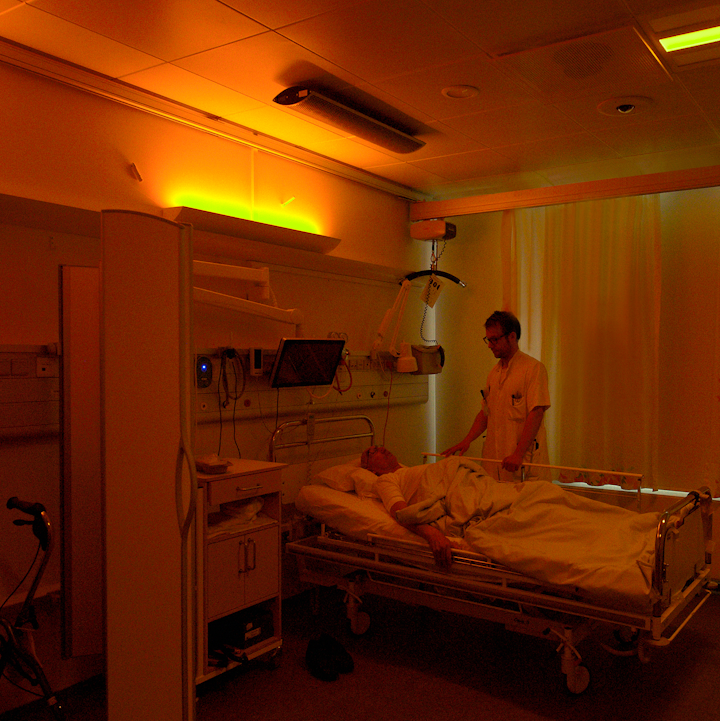Maybe you also want this even though it is in mice.
Moderate ultraviolet light exposure boosts the brainpower of mice thanks to increased production of the neurotransmitter glutamate May 2018
Or all these:
blue light (8)
The latest here:
Hospital: Lighting helps stroke patients deal with fatigue, depression
Copenhagen
study shows that circadian-tuned LED brights and spectrum can help,
although it might depend on how you measure things.
Feb 19th, 2020

A
stroke patient under soft warm nighttime lighting at Righospitalet,
with neurologist Anders West of the University of Copenhagen. (Photo
credit: Image courtesy of Chromaviso.)
Studies
of 90 stroke patients in a Danish hospital indicate that LED lighting
tuned to mimic the patterns of daylight can have a positive effect on
depression, fatigue, anxiety, and wellbeing, although there was some
amount of inconclusiveness, and lighting made no difference in cognition
improvement.
The results of the observations at
the Stroke Rehabilitation Unit in Copenhagen's Righospitalet from May
2014 through June 2015 were only recently published in the journal NeuroRehabilitation.
Righospitalet
is part of the Copenhagen University Hospital. The studies were
conducted by the the University of Copenhagen's departments of neurology
and neurophysiology and by the hospital's department of ophthalmology,
using specialty lighting from Chromaviso, based in Aarhus, Denmark.
The
scientists generally tuned lighting in patient rooms to deliver the
brighter and more blue-rich makeup associated with natural daylight
during the mornings and afternoons. They toned down the brightness and
delivered warmer spectral content in the evenings.
At the same time they delivered ordinary hospital lighting to control groups.
Read more like this: New studies show cycles of blue and red light promote circadian entrainment
The
team worked on the hypothesis that the tuned lighting would support
human circadian rhythms associated with the 24-hour cycle of day and
night, whereas ordinary hospital lighting and indoor confinement
deprives patients of circadian normalities and can thus cause
physiological disturbances.
All patients were hospitalized for over two weeks.
In
one study focused on fatigue, they concluded that “fatigue was
significantly reduced in rehabilitation patients exposed to naturalistic
lighting during admission.” They based their conclusion
on a couple of questionnaires, one called the Multidimensional Fatigue
Inventory questionnaire, and the other the Rested Statement, noting that
the experimental groups reported less fatigue compared to the control
group.
However, by another measurement, the
Pittsburgh Sleep Quality Index, “no differences were detected between
groups in sleepiness or subjective sleep quality,” wrote the authors,
led by Anders West from the neurology department.
Read more like this: Blue-light study shows promise in healing mild TBI
If
those results were encouraging but mixed, the same could be said of a
separate set of observations looking at a combination of depression,
anxiety, wellbeing, and cognition.
“Depressive
mood and anxiety was reduced, and wellbeing was increased in the
(experimental) group at discharge compared to the (control group),” the
authors reported.
However, “no difference was found in cognition,” the authors stated.
The
team applied the Hamilton Depression Scale, the Major Depression
Inventory, the WHO-Five Well-being Index, the Hospital Anxiety and
Depression Scale, and the Montreal Cognitive Assessment to determine the
results.
“This study is the first to demonstrate
that exposure to naturalistic light during admission may significantly
improve mental health in rehabilitation patients,” they concluded,
adding that “further studies are needed to confirm these findings.”
Chromaviso has been very active in lighting tuned to health and recovery, in areas including dementia, psychiatric disorders, brain trauma, surgery, and others.
MARK HALPER is a contributing editor for LEDs Magazine, and an energy, technology, and business journalist (markhalper@aol.com).
No comments:
Post a Comment